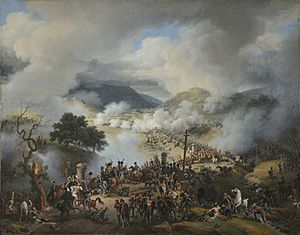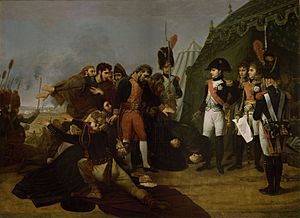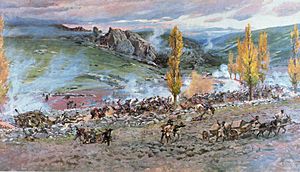Battle of Somosierra facts for kids
Quick facts for kids Battle of Somosierra |
|||||||
|---|---|---|---|---|---|---|---|
| Part of the Peninsular War | |||||||
 La bataille de Somo-Sierra, 1810, Baron Lejeune |
|||||||
|
|||||||
| Belligerents | |||||||
| Commanders and leaders | |||||||
| Strength | |||||||
| 8,000 | 12,000 | ||||||
| Casualties and losses | |||||||
| 300 | 2,200 | ||||||
The Battle of Somosierra happened on November 30, 1808. It was a key moment during the Peninsular War. In this battle, a large army led by Napoleon Bonaparte fought its way through a Spanish army. This Spanish force was guarding the Sierra de Guadarrama mountains. This mountain pass was the last big obstacle protecting Madrid from a direct attack by Napoleon's army.
At the Somosierra Pass, about 60 miles north of Madrid, a smaller Spanish group tried to stop Napoleon. This group included regular soldiers, volunteers, and artillery (cannons). They were led by Benito de San Juan. Napoleon's forces were much larger. He used a clever attack, sending his Polish cavalry, called Chevau-légers, directly at the Spanish cannons. Meanwhile, French foot soldiers moved up the mountain slopes. This victory cleared the way to Madrid, which fell to the French just a few days later.
Contents
Why the Battle Happened
Napoleon's plan to take over Spain had begun earlier in 1808. By late November, his powerful army, called the Grande Armée, had already defeated many Spanish forces. To finish his takeover of Spain, Napoleon marched towards Madrid with 40,000 soldiers.
General San Juan quickly gathered a mixed army to defend Madrid. This army had about 12,000 men. It included local fighters, reserve soldiers, and some regular army units. To protect the city from different directions, San Juan spread out his smaller army. He sent 9,000 men to guard the Guadarrama pass. Another 3,000 went to a forward position at Sepulveda. This left only 9,000 men and 16 cannons at the Somosierra heights. The tough mountain land and the Spanish soldiers' determination initially helped them.
On the evening of November 28, a Spanish group at Sepúlveda fought off a French attack. The Spanish soldiers had to pull back in the dark. This happened after their cavalry (horse soldiers) were defeated by French cavalry. On the morning of November 30, Napoleon sent his foot soldiers directly towards the pass. Smaller groups of French soldiers also tried to sneak around the sides. The French slowly moved forward, exchanging gunfire with the Spanish defenders.
The Battle of Somosierra
The Spanish forces were hard to get around with just foot soldiers. Napoleon was in a hurry, so he gave a daring order. He told his Polish Chevaux-Légers escort squadron to charge the Spanish cannons. This first group had about 125 men. Other Polish cavalry joined later, bringing the total to about 450 men. But the first charge of 125 men went straight for the cannons.

Some people thought Napoleon was crazy to order cavalry to charge 16 cannons over very difficult ground. Others believe he only meant for them to take the first group of cannons. This would open the way for his foot soldiers. But once the charge started, the chevaux-légers were under fire from the second group of cannons. They had no choice but to keep going. Their horses were moving too fast to stop. They took the second and third groups of cannons. Only a few cavalrymen reached the last group of cannons. The Spanish tried to take back their cannons. That's when Napoleon saw his chance and sent in the other cavalry squadrons.
General Benito de San Juan had 16 cannons. They were set up in four groups. Some stories say all the cannons were at the very top of the Somosierra pass. But if they were, they couldn't have hit much of the French army. There were reports that Napoleon himself was sometimes under cannon fire. The first group of cannons protected the entrance to the pass. The next two covered the pass from different angles. Only the fourth group was at the very top.
The charge was led by Jan Kozietulski. But he lost his horse after taking the first group of cannons. Then, Lieutenant Andrzej Niegolewski joined the squadron. The charge continued under another officer, Dziewanowski. When he fell, Piotr Krasiński took over. The final push to the last group of cannons was led by Niegolewski. He was badly wounded but survived the fierce Spanish attack.
Many soldiers remembered that the official battle cry was "Vive l'Empereur" (Long live the Emperor). But a popular story says the real cry was in Polish: "Naprzód, Cesarz patrzy" (Forward, the Emperor is watching).
After the fourth group of cannons was taken, Napoleon ordered more of his soldiers to attack. This included his Chasseurs of the Guard and the first squadron of Poles. They were led by Tomasz Łubieński. Their job was to drive the Spanish completely out of the Pass.
What Happened After the Charge
Official reports from the French army highlighted the main role of the Polish cavalry. Only a cavalry charge was able to take all four groups of cannons. This happened even though French foot soldiers were close behind. The charge caused many Spanish local fighters to run away. This led to the retreat of the entire Spanish army. Spanish cannon operators often chose to die rather than leave their positions. But Polish accounts didn't mention much fighting with the Spanish local fighters. These fighters simply left their positions. They saw how easily the Poles seemed to take the cannon positions. However, in the smoke, they couldn't see how few Poles actually reached the top.
Aftermath of the Battle

General San Juan quickly led his army back to Madrid. The victory at Somosierra was actually a team effort. Both foot soldiers and cavalry fought hard, with the foot soldiers doing much of the heavy fighting. But later stories, including Napoleon's own, focused mostly on the amazing Polish cavalry charge. San Juan was later killed by his own men.
French patrols reached the edges of Madrid on December 1. The Spanish government tried to defend the capital, but it was a weak effort. On December 4, a powerful French cannon attack broke the Spanish defense. The Spanish surrendered their remaining 2,500 regular soldiers. The 20,000 civilians who had joined the defense scattered. The French army entered Madrid for the second time that year.
See also
 In Spanish: Batalla de Somosierra para niños
In Spanish: Batalla de Somosierra para niños


